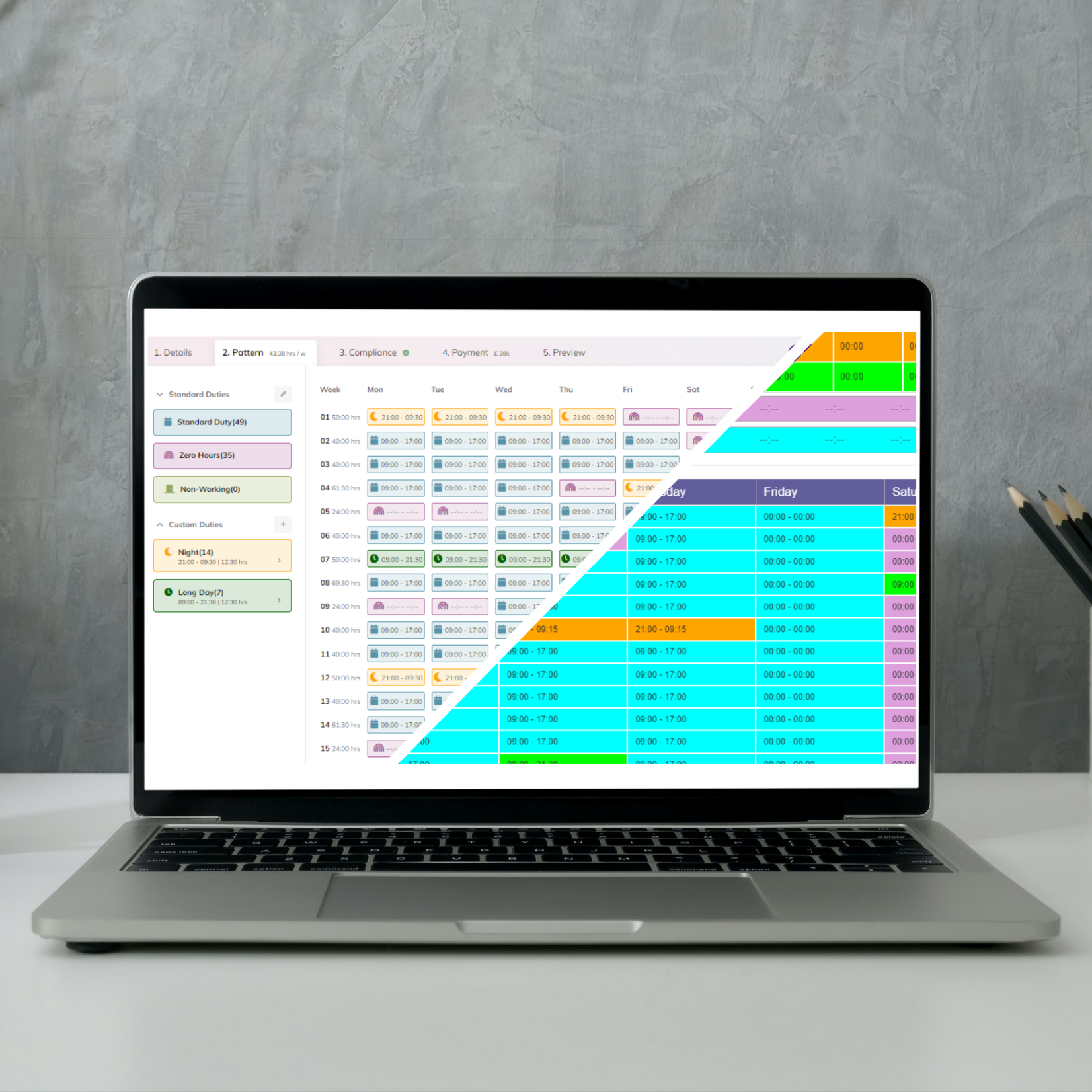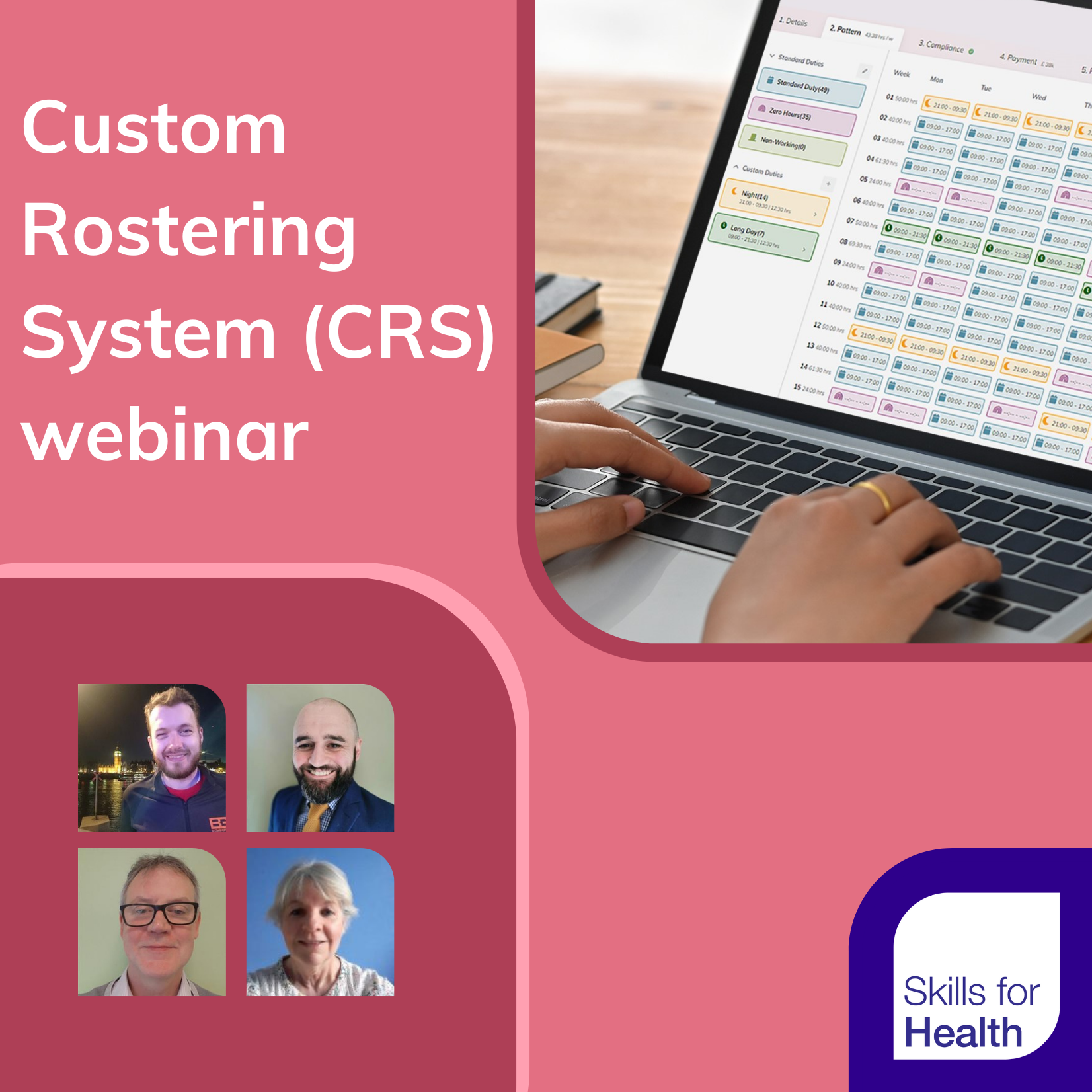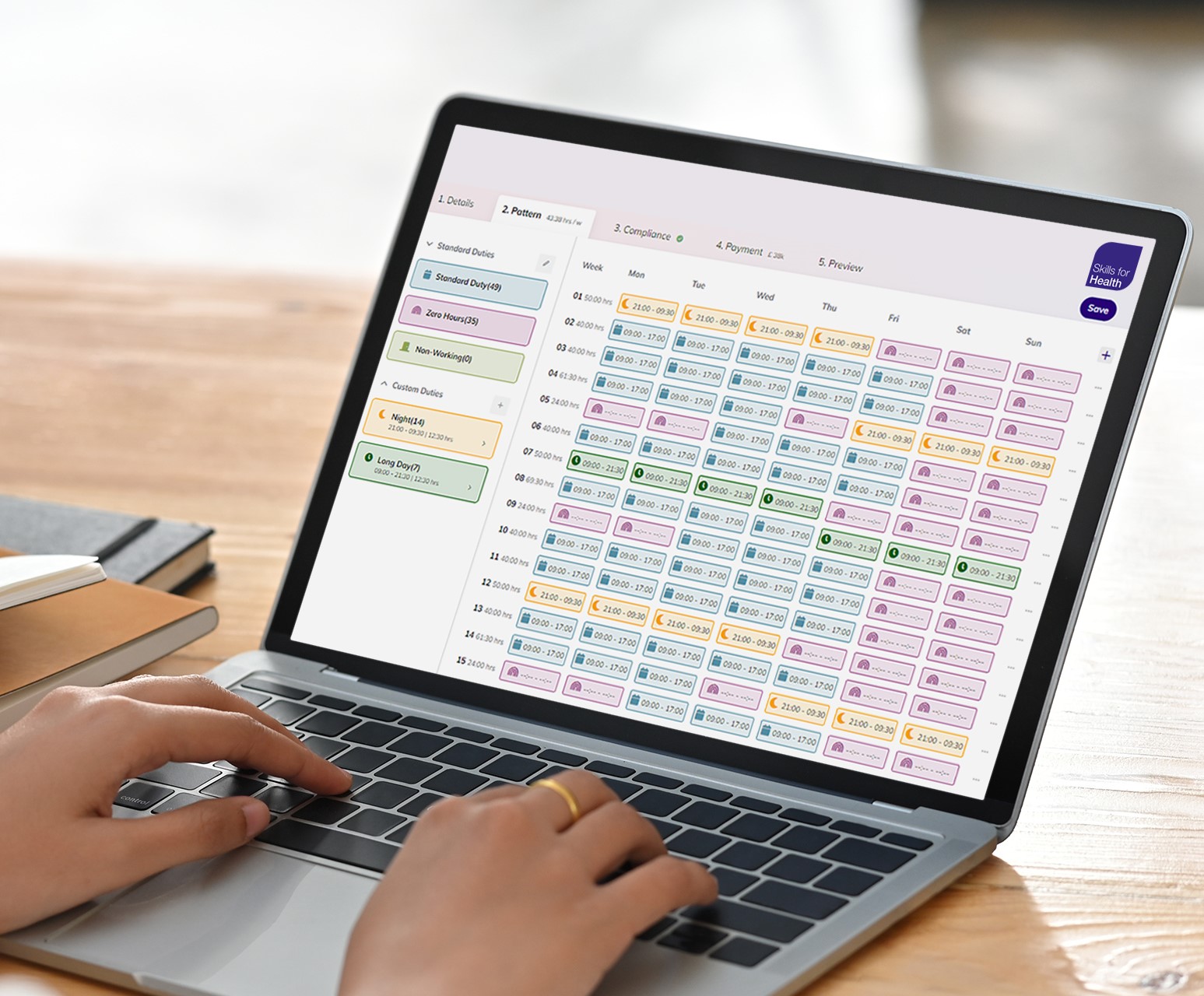Custom Rostering System
An early adopter’s view on switching from DRS4 to CRS
Oxleas NHS Foundation Trust recently joined the early adoption programme for Skills for Health’s Custom Rostering System (CRS), having used the former solution, DRS (Doctors Rostering System), for several years.
In this section:

The situation before CRS
Callum Livermore, Medical Staffing Officer at Oxleas, recently reviewed the implementation of CRS with Technical Account Manager, Zach Kerray.
“When I joined Oxleas, we had DRS4 for management of Junior Doctors Contracts terms and conditions. Without DRS, it would be near impossible to work out all the different compliance rules. It enabled trainee doctors to report ‘exceptions’ so that we could make the necessary amendments and prevent them from reoccurring in the future.
“We used DRS for managing our trainee work patterns. We set up our general patterns, which we use every rotation. They don’t tend to change but when we have less than full time (LTFT) trainees, we set up their bespoke work patterns on DRS4; put in the shifts that they’ve been allocated, getting their contribution, which then, in turn, gives us their salary figure.
“The higher trainees’ pattern does fluctuate depending on how many trainees we get, so we would always use DRS4 to plot the new higher trainee rota. But because it’s a 1:10 to a 1:16, we have the pattern set up. We just choose whichever pattern we are going to be using for that rotation. LTFT Trainees is what we would mainly use the work patterns for, because they’re always bespoke, always different and they always have different salaries. So, we were always using DRS4 to put LTFT patterns in, ensuring compliance and calculating their salary.”
Managing an increasing workload

Less Than Full-Time roles are increasingly common and add variations to the work pattern. Medical staffing departments are having to create more patterns and more work schedules and there is no additional time for this increase in workload. CRS manages that variation simply and effectively.
“We are seeing more LTFT trainees coming in. Four or five times as many as when I started, four years ago.”
Callum’s team has managed actual live rotas, using spreadsheets, swapping shifts and arranging leave. CRS will help reduce the burden of managing additional work patterns and rotas from different departments and will support NHS Trusts like Oxleas to manage the operational aspect of compliance-based rostering for staff.
We are seeing more LTFT trainees coming in. Four or five times as many as when I started, four years ago.
Callum Livermore, Medical Staffing Officer, Oxleas NHS Foundation Trust
Implementing CRS
Oxleas became an ‘early adopter’ of CRS in September 2021.
“We are always looking for ways to improve and I attended the webinar about CRS when it first came out. I watched it and thought that there are so many improvements which would be really good to have. When we were contacted to be an early adopter, I discussed it with Tracy, my line manager and she asked me if I’d be happy to take this forward as a project. I said we should go for it. Getting access to the system and entering all of the data has been really quite easy, especially with the support team at Skills for Health helping us, talking us through things. So, the implementation has been really good.”
Happy with how the implementation is going, Callum plans for consultants to begin using it shortly. “CRS has a different layout to DRS4, so we’ll go through how to use it and I don’t foresee any issues.”

CRS v DRS4 for compliance and exception reporting

After just a few months of using CRS, Callum is already seeing improvements in the functionality for compliance and exception reporting.
“Straight away, one of the improvements for me was being able to edit a week. In DRS4, if you make a mistake, you have to go back to the beginning and do it all again. But in CRS you can find that mistake, delete the week, input the one week again or shift the weeks around and then it’s fixed. So, it will definitely save us time, especially when you consider that we are doing this while cross-referencing with a manual spreadsheet as well.
“In CRS, being able to add and delete a week is just a really user-friendly feature that I think everyone would enjoy.”
Callum is referring to the isolation controls. With this type of functionality, CRS provides more control, making it easier to produce the patterns within the allowed time. CRS has been designed to be much cleaner and more intuitive to use, taking the user through the process of building work patterns. It also tells you about compliance issues as you build your rota, and an app will allow the reporting and managing of exceptions, ‘on the go.’
CRS is customisable, to meet your needs
“It’s easier on the eye, too. It’s more colourful and you can choose your colours and icons. The User Interface is much, much better and I like that the parts of the pattern are separated off. So, you start with just the general title of the pattern, who it’s for, and then you move on and you’ve got the pattern, and then you move on and you’ve got the rules. So, it’s all separated off quite nicely. And then you finally have the salary at the end as well.”
That is a small part of the customisable nature of CRS. You can tailor the system to meet your specific requirements, whether that is the colours and icons that direct people around the system or the views of the rosters. Different roster views will be required by people within the same organisation, whether it is a relatively small mental health Trust or an acute hospital Trust.
“Another advantage is that you can differentiate between an off day and a zero-day, although they’re the same sort of thing, you do get queries from trainees. So, having it as an off day and then zero days following nights, especially for the LTFT trainees, is great.”

Benefits combine to have a significant effect on efficiency

“I can see that CRS is designed to be much quicker. When you open a pattern it takes you to a different view, rather than opening within the same page, so the information loads instantly.
“Many small benefits in CRS combine to have a significant effect on efficiency. Then, there are stand-out improvements, such as the pre-emptive compliance checks, when the system tells you where your compliance problems are before you complete your rota. Other systems don’t have this feature which provides a better experience and helps build work patterns more quickly and more efficiently.
“Another thing I like is that when you have a pattern in draft, you can just delete it altogether so that you don’t have a massive list of patterns. We can archive them and then filter them out, but there’s a lot of them we don’t want to archive.”
There are stand-out improvements, such as the pre-emptive compliance checks, when the system tells you where your compliance problems are before you complete your rota.
Callum Livermore, Medical Staffing Officer, Oxleas NHS Foundation Trust
Additional CRS features, going further than DRS4
“We sometimes get tasked with determining, ‘How much would it cost to run this rota? Should we look at doing it?’ Whilst DRS4 will give you the standard salary per doctor, it doesn’t work out the total cost of the rota or the out of hours portion as CRS does. CRS does all of that background work and then generates the salary and cost of the rota for you. Many things we do in the background, can be done in CRS, saving us time. Managing swaps manually will occasionally lead to an error, so that’s something that we would look to move onto CRS. Using CRS for actual live rotas will be a big step forward because we’ve always used manual rotas.
“The consultants will be happy to start using exception reporting, and even more so with the e-rostering. If we have our doctors and our consultants swapping shifts and managing leave on their mobiles, they’ll be far happier, I’m sure.”

Using CRS for actual live rotas will be a big step forward because we’ve always used manual rotas.
Callum Livermore, Medical Staffing Officer, Oxleas NHS Foundation Trust
Working with Skills for Health and replacing DRS4

“CRS is such an improvement on DRS4 as it has everything needed, especially for compliance. It will show you which rules are broken, how, and why they’re broken, and it will direct you to the week of the non-compliance and to the shifts which are affected. So, for anyone preparing rotas for medical staff, and potentially other staff, CRS is a great compliance tool.
I would definitely recommend working with Skills for Health. Even using DRS4, when I’ve had to raise queries through the website, they’ve always been so responsive. They are really quick at getting back and really informative, really helpful.”
With the implementation of CRS, right from the beginning, the team has always been there to support, always answered any questions, no matter how silly they are! They’ve always been responsive and helpful.
Callum Livermore – Oxleas NHS Foundation Trust
Book a demo
Available virtually, we’ll show you all the key features that NHS organisations trust to accurately and safely manage staff rosters, designed specifically for the needs of the health sector.

Training and compliance insights
Read specialist insight pieces from some of the health sector’s leading experts – or download brochures, case studies and reports from our extensive library.
